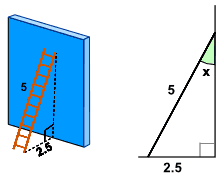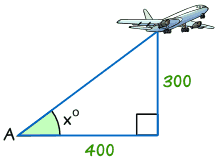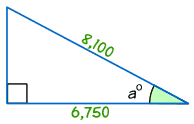how to find an angle of a right triangle
Finding an Bending in a Right Angled Triangle
Angle from Whatever Two Sides
We can find an unknown angle in a right-angled triangle, as long every bit we know the lengths of two of its sides.

Example
The ladder leans against a wall as shown.
What is the angle betwixt the ladder and the wall?
The answer is to utilize Sine, Cosine or Tangent!
But which one to use? Nosotros have a special phrase "SOHCAHTOA" to help usa, and we apply it like this:
Step one: find the names of the ii sides we know

- Adjacent is adjacent to the bending,
- Opposite is opposite the angle,
- and the longest side is the Hypotenuse.
Example: in our ladder example we know the length of:
- the side Reverse the bending "ten", which is two.5
- the longest side, called the Hypotenuse, which is 5
Step 2: at present use the first letters of those two sides (Opposite and Hypotenuse) and the phrase "SOHCAHTOA" to observe which one of Sine, Cosine or Tangent to use:
| SOH... | Sine: sin(θ) = Opposite / Hypotenuse |
| ...CAH... | Cosine: cos(θ) = Adjacent / Hypotenuse |
| ...TOA | Tangent: tan(θ) = Opposite / Adjacent |
In our example that is Opposite and Hypotenuse, and that gives us "SOHcahtoa", which tells us nosotros need to use Sine.
Step 3: Put our values into the Sine equation:
Due southin (x) = Opposite / Hypotenuse = 2.5 / v = 0.5
Step 4: At present solve that equation!
sin(ten) = 0.5
Next (trust me for the moment) nosotros can re-accommodate that into this:
ten = sin-1(0.five)
And so get our reckoner, key in 0.5 and utilize the sin-1 button to get the respond:
ten = xxx°
But what is the meaning of sin-ane … ?
Well, the Sine function "sin" takes an bending and gives u.s.a. the ratio "contrary/hypotenuse",

Just sin-1 (called "inverse sine") goes the other way ...
... information technology takes the ratio "reverse/hypotenuse" and gives us an angle.
Instance:
- Sine Function: sin(30°) = 0.5
- Inverse Sine Part: sin-one(0.5) = 30°
 | On the reckoner press one of the following (depending on your brand of calculator): either '2ndF sin' or 'shift sin'. |
On your calculator, try using sin and sin-1 to see what results yous go!
Also try cos and cos-one . And tan and tan-1 .
Continue, accept a attempt now.
Pace By Stride
These are the four steps we demand to follow:
- Step 1 Find which two sides we know – out of Reverse, Adjacent and Hypotenuse.
- Pace 2 Employ SOHCAHTOA to decide which 1 of Sine, Cosine or Tangent to utilize in this question.
- Step 3 For Sine summate Reverse/Hypotenuse, for Cosine calculate Adjacent/Hypotenuse or for Tangent summate Opposite/Adjacent.
- Step 4 Find the angle from your calculator, using one of sin-ane, cos-1 or tan-1
Examples
Permit's look at a couple more examples:

Example
Observe the angle of peak of the plane from point A on the ground.
- Step i The ii sides we know are Opposite (300) and Adjacent (400).
- Step 2 SOHCAHTOA tells us nosotros must employ Tangent.
- Step 3 Summate Contrary/Adjacent = 300/400 = 0.75
- Footstep 4 Find the bending from your estimator using tan-ane
Tan x° = opposite/side by side = 300/400 = 0.75
tan-1 of 0.75 = 36.ix° (correct to 1 decimal place)
Unless you're told otherwise, angles are normally rounded to one place of decimals.

Example
Find the size of angle a°
- Step one The two sides nosotros know are Adjacent (6,750) and Hypotenuse (eight,100).
- Pace 2 SOHCAHTOA tells u.s.a. we must use Cosine.
- Step three Calculate Adjacent / Hypotenuse = half-dozen,750/8,100 = 0.8333
- Step 4 Find the bending from your figurer using cos-one of 0.8333:
cos a° = 6,750/8,100 = 0.8333
cos-1 of 0.8333 = 33.six° (to ane decimal identify)
250, 1500, 1501, 1502, 251, 1503, 2349, 2350, 2351, 3934
Source: https://www.mathsisfun.com/algebra/trig-finding-angle-right-triangle.html
Posted by: mayonsivionts1979.blogspot.com

0 Response to "how to find an angle of a right triangle"
Post a Comment